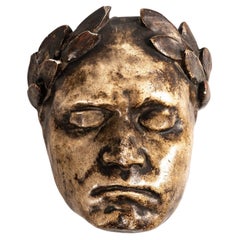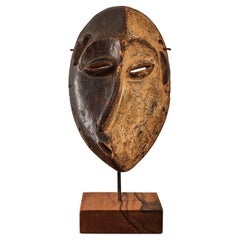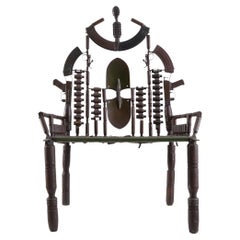Mozambican Figurative Sculptures
2
1
to
3
3
3
3
2
1
2
Height
to
Width
to
2
1
333
11,074
3,591
3,153
1,925
1
Place of Origin: Mozambican
Vintage Carved Family Statue, Tribal, Hardstone, Decorative Ornament, circa 1960
Located in Hele, Devon, GB
This is a vintage carved family statue. A tirbal African, polished hardstone decorative ornament, dating to the mid 20th century, circa 1960.
Beautifu...
Category
Mid-20th Century Tribal Mozambican Figurative Sculptures
Materials
Stone
Vintage Abstract Family Statue, Tribal, Hardstone, Decorative Ornament, C.1960
Located in Hele, Devon, GB
This is a vintage abstract family statue. A tribal African, polished hardstone decorative ornament, dating to the mid 20th century, circa 1960.
A pare...
Category
Mid-20th Century Tribal Mozambican Figurative Sculptures
Materials
Stone
Goncalo Mabunda War, Mask, 2017
By Gonçalo Mabunda
Located in Untersiggenthal, AG
Goncalo Mabunda's wall sculptures are made from decommissed weapons.
His artworks are exhibtited all over the world.
Category
21st Century and Contemporary Mozambican Figurative Sculptures
Materials
Metal
Related Items
A Beethoven Sculpture Mask, 1950s
By Franz von Stuck
Located in BARCELONA, ES
Investing in this Beethoven Sculpture Mask, reminiscent of the style of Franz von Stuck and dating back to the 1950s, offers a unique opportunity to own a piece of timeless artistic ...
Category
1950s Mid-Century Modern Vintage Mozambican Figurative Sculptures
Materials
Plaster
Pende Illness Mbangu Mask
Located in Long Island City, NY
Pende Illness Mbangu Mask on a wooden base.
Category
20th Century Mozambican Figurative Sculptures
Materials
Wood
Vintage French Christian Dior Advertising Statue, 1960s
Located in HEVERLEE, BE
Beautiful and intruiging advertising statue for Christian Dior.
This would have been used on a shop counter or to draw attention in a shop windo...
Category
1960s Art Deco Vintage Mozambican Figurative Sculptures
Materials
Plaster
Vintage French Christian Dior Advertising Statue, 1960s
Located in HEVERLEE, BE
Beautiful and intruiging advertising statue for Christian Dior.
This would have been used on a shop counter or to draw attention in a shop windo...
Category
1960s Art Deco Vintage Mozambican Figurative Sculptures
Materials
Plaster
Vintage Terracotta Statue by Josef Vanča, 1960's
Located in Praha, CZ
Vintage terracotta sculpture. Beautiful piece of female nude, marked J.Vanca.
Josef Vanca (1908-1988), sculptor and ceramist, was born in...
Category
Mid-20th Century Mid-Century Modern Mozambican Figurative Sculptures
Materials
Terracotta
Vintage Decorative Gold Bee Ornament Bumble Bee Sculpture LUXURY ORNAMENT GOLD
Located in Hampshire, GB
A beautiful vintage gold bee ornament for your room. An impressive size, this gold bee is a beautiful statement piece for a shelf or sideboard!
29 x 15 x 13cm
Category
1980s Art Deco Vintage Mozambican Figurative Sculptures
Materials
Metal, Gold Plate, Sheet Metal, Gold Leaf
Free Shipping
H 5.12 in W 11.42 in D 5.91 in
Vintage French Christian Dior Advertising Statue, 1960s
Located in HEVERLEE, BE
Beautiful and intriguing advertising statue for Christian Dior.
This would have been used on a shop counter or to draw attention in a shop windo...
Category
1960s Art Deco Vintage Mozambican Figurative Sculptures
Materials
Plaster
Tribal Wood Carved Statue
Located in East Hampton, NY
Tribal wood carved statue. Unknown origin.
Category
20th Century Mozambican Figurative Sculptures
Materials
Wood
Vintage Decorative Egyptian Pharaoh Statue on Marble Base, Grand Tour Souvenir
Located in Nuernberg, DE
A beautifully crafted statue of an ancient Egyptian pharaoh, I believe it is Ramses the 2nd however I am not completely sure. The statue appears to be made of copper or white metal. ...
Category
1970s Mid-Century Modern Vintage Mozambican Figurative Sculptures
Materials
Marble, Metal
H 9.25 in W 3 in D 5.38 in
Decorative Hand-Carved African Statue from Kenya
Located in North Hollywood, CA
Decorative ebony well hand-carved African statue of a young women.
Handmade in Kenya, Africa.
Category
Mid-20th Century Folk Art Mozambican Figurative Sculptures
Materials
Ebony
Exceptional Egyptian Sarcophagus Mask
Located in London, GB
Exceptionally Fine Wooden Sarcophagus Mask
Third Intermediate Period, 21st Dynasty, circa 1069-945 BC.
Acacia wood, rosewood, hippopotamus ivory
Masterfully carved from a single piece of fine-grained hardwood, the present mask is characteristic of the most exquisite funerary art made during the 21st Dynasty, and was probably commissioned for a particularly high-ranking individual.
The oval face displays a gently smiling mouth with full, outlined lips, furrows at the corners and a bow-shaped philtrum. The straight nose with rounded nostrils, the cheeks full and fleshy and the large, almond shaped eyes with heavy lids and tapering cosmetic lines, set below long, sweeping eyebrows.
Social collapse across the Mediterranean in the Late Bronze Age meant that the 21st Dynasty in Egypt was a period of great turmoil. Trade routes were disrupted, governments collapsed, and mass migration occurred. Economic scarcity meant that traditional funerary practices in Egypt were also affected, with a lack of material and financial resources leading to the reuse of preexisting material. As a result, during the 21st Dynasty, 19th and 20th Dynasty coffins changed ownership rapidly and were heavily recycled for new purposes. Tombs were also unmarked allowing them to be shared
by many people. These new practices brought forth a shift in the understanding of funerary paraphernalia. No longer important objects owned forever by the deceased, they were now simply seen as short-term transformative devices, whose symbolic and ritualistic meaning could be appropriated for others. However, paradoxically, the art of coffin-making also reached new heights during this period, and many of the richly dec- orated “yellow” coffins, characteristic of the 21st Dynasty, are remarkable works of art in their own right. Indeed, knowing that coffins were being reused throughout Egypt, the Egyptian élite set themself apart by commissioning lavish sarcophagi decorated with the images and texts meant to help guide them to the afterlife, and which would otherwise have adorned the tomb walls. As coffins were the chief funerary element which now identified the dead and allowed them a physical presence in the world of the living, their quality and appearance were of the utmost importance.
The traditional coffin ensemble was made of three parts: a wooden mummy cover, which laid directly atop the mummy, an inner coffin, and an outer coffin, both made of a lid and case. Additional decorative elements, such as masks, were carved out separately and later glued or pegged to the lids. After the completion of the painted decoration, the sarcophagus was covered in a varnish to give it its yellow colour. Gilding was sometimes used for the coffins of the high priests’ families, notably on parts representing naked skin, such as the face mask. However, some of the élite tactically avoided gilding altogether as to ensure that their coffin would not be looted.
When manufacturing the inner and outer coffins, particular attention was paid to the woodwork. Displaying the skill of the carpenter, this type of funerary art has largely remained unparalleled throughout Egyptian history. The principal wood used to craft the present mask is Acacia nilotica. The evergreen Egyptian acacia was considered sacred and said to be the tree of life, the birthplace of the god Horus, as well as symbolic of Osiris, the god of the dead and resurrection. The modelling of the face in the wood is superb, but the inlays also help mark this mask out as exceptional. Inlaid eyes and eyebrows were extremely rare and reserved to the finest and most expensive coffins. Traditionally, eyes were made of calcite, obsidian, or quartz, and eyebrows of coloured glass paste or bronze. Here, the pupils, eyebrows, and cosmetic lines are inlaid with Dalbergia melanoxylon, a rare type of wood which belongs to the rosewood genus.
In antiquity, however, it was known as Ebony of the Pharaohs, from the Egyptian word “hbny”, meaning dark timber, because of its black, lustrous appearance. An extremely dense and hard wood requiring significant skill to work with, ebony was a luxury material highly coveted by the pharaohs themselves, to make furniture, decorative and funerary objects. The wood was imported with great effort from the southern Land of Punt, most likely modern Sudan, Ethiopia, Djibouti, and Eritrea, alongside other luxury goods such as gold and ivory.
A magnificent ebony throne, recovered in the tomb of King Tutankhamun, illustrates the incredible aesthetic potential of this material and why it was so highly valued by Egyptian royalty. Only élite members of Egyptian society could have afford- ed Ebony of the Pharaoh inlays for their funerary mask.
The sclerae on the present piece were once both inlaid with hippopotamus ivory. Whiter than elephant ivory, this type of ivory is also denser, and more difficult to carve. The use of this luxury material, reputed for its gleaming appearance, enhances the lifelikeness of the eyes. For the Egyptians, hippopotamus ivory was imbued with magic powers. The hippopotamus was indeed both feared and venerated due to its aggressive behaviour. Whilst the male hippopotamus was associated with danger and chaos, the female was benevolent and invoked for protection, especially of the house and
of mothers and their children, through the hippopotamus goddess Tawaret. Thus, not only was hippopotamus ivory used as an inlay and to make practical objects, such as combs and clappers, but it was also used to make talismans like apotropaic wands or knives.
Made during a time of scarcity where few could afford made-to-order coffins, the present mask could have only belonged to one of the highest-ranking individuals in society. Undoubtedly one of the finest Egyptian coffin...
Category
15th Century and Earlier Egyptian Antique Mozambican Figurative Sculptures
Materials
Fruitwood, Hardwood
Decorative Sculpture Ornament Rose Blossom Solid Block Rose Quartz Hand Carved
By Barberini & Gunnell
Located in Ancona, Marche
Rose blossom sculpted entirely by hand starting from a solid block of rare rose quartz.
Dimensions: approximately D 12 x H 12 cm. Available in different...
Category
21st Century and Contemporary Modern Mozambican Figurative Sculptures
Materials
Rose Quartz
H 4.73 in W 4.73 in D 4.73 in
Previously Available Items
Goncalo Mabunda War-Throne 2015
By Gonçalo Mabunda
Located in Untersiggenthal, AG
One of the first War- Thrones Goncalo Mabunda made from decommissed weapons.
His artworks are exhibtited all over the world.
Category
21st Century and Contemporary Mozambican Figurative Sculptures
Materials
Metal
Vintage Well Carved Maconde Helmet Mask, Mozambique or Tanzania Mid 20th C
Located in Ft. Lauderdale, FL
This expressive Maconde Helmet mask from Mozambique or Tanzania (the Maconde people live in both countries) is carved in wood with good detail and traditional scarification marks in ...
Category
Mid-20th Century Tribal Mozambican Figurative Sculptures
Materials
Wood
Dayak People, Borneo, Small Ceremonial Figure with Crusted Patina
Located in Leuven , BE
Beautiful ceremonial figure with crusted patina from Mozambique.
Category
Early 20th Century Mozambican Figurative Sculptures
Materials
Wood
Recently Viewed
View AllMore Ways To Browse
Green Marble Decor
Art Deco Bronze Marble Onyx
African Sculptures African Wood Masks
American Indian Arts
Indian Headdress
Musician 18th Century
Solid Gold Statue
Winged Cherubs Sculpture
Solid Bronze Statues
Giacometti Style Sculpture
Art Nouveau Lady Sculpture
Metal Torso Sculpture
Equestrian Statue
Indian Head Sculpture
Late Renaissance Florence
Antique Trident
Bronze Male Head
Bronze Age Pottery






